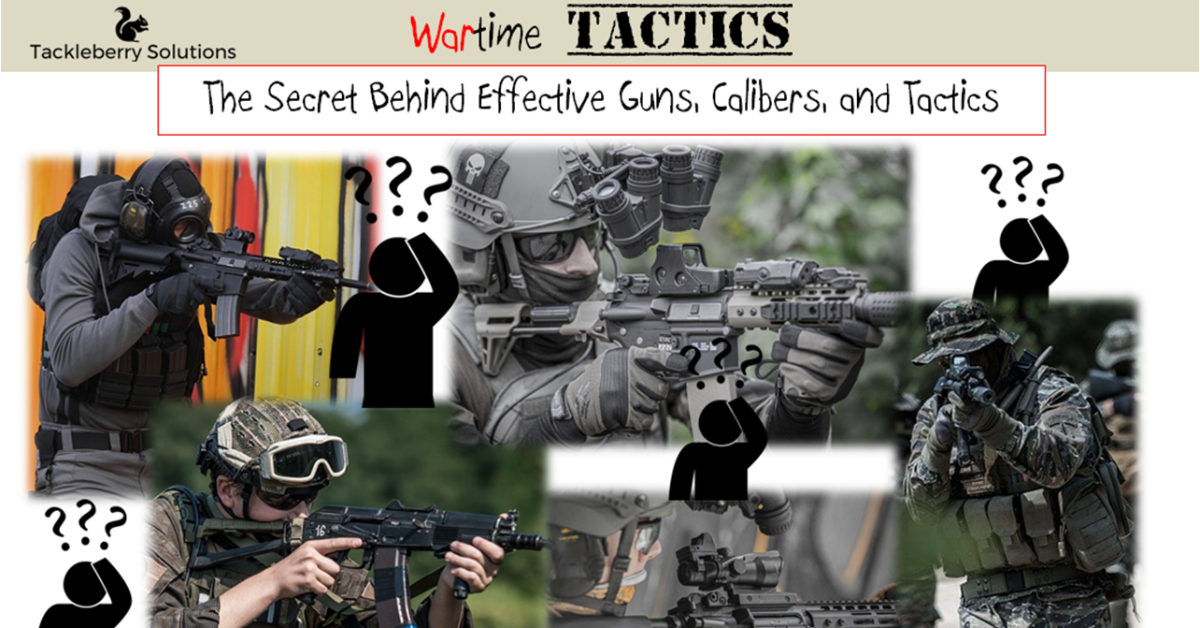Effective Wartime Tactics: Don't fall for that fancy guy with cool gadgets and impressive shooting moves. He'll get you killed.

Hello, my name is Arthur and I teach wartime tactics. Today I'm going to go into a topic that has a lot of controversy. However, I can't help but speak up because 90% of what you hear is some dude showing off who has never been in a real fire-fight or someone else trying to get you to spend money. Don't fall for either.
Intro to Effective Gun, Calibers & Tactics
I don't usually go into these kind of topics. However, I keep getting asked the same questions and I'm tired of seeing so many people getting scammed into the wrong hype. This includes both gear scams and tactical foolery.
You want to know which guns to buy, which caliber is the best and the "fastest" way to shoot tactically? Hopefully I'll be able to answer your question and save you some money and heartache in the long run.
Video shut down? Click here to watch it on Ugetube. *Note* The article below is just an outline - you'll get more info by watching the video.
The Most Effective Guns/Equipment
Body Armor
Armor isn't all that it has been made out to be. Especially those tiny plate carriers that barely even cover your heart. Not to mention that they can be heavy and slow you down.
Moreover, the fact that people in combat commonly wear body armor has caused a lot of attackers to start shooting at the groin instead. Which is just as deadly.
In conclusion, if you are going to wear body armor:
- Make sure it'll cover more than just your heart (lungs and diaphragm are just as important), but you still need to be able to bend over (ie. make sure it fits!)
- Go running with it on - get used to moving in it
Suppressors
Your weaponry needs to be applicable to your unique situation. Suppressors extend the barrel of your weapon anywhere from 6 to 8 inches. So if you've got a sweet 10" rifle and you add a suppressor, now your rocking an 18" weapon. That is going to make a big difference if you expect to use it indoors with close quarters.
Furthermore, if you've got a standard 16" barrel and you add a suppressor to it, you end up with a 24" long stick. Good luck clearing a building with that one. You'll be clocking everything over.
Is that necessary when you can just go with volume smart ear protection?
The original purpose behind the suppressor was to help Special Operations or other high risk groups such as Recon go longer without detection from the enemy.
So when you're considering a suppressor, ask yourself these questions:
- Am I trying to hide my presence? (If you're just protecting your home or shooting offensively, then the answer is "no, I don't need one.")
- Is ear protection out of the picture? (If you've got a guard dog or others in your home that you're worried about, then you may need a suppressor.)
- Do I want to intimidate my attacker? (Suppressing the noise is gonna take out a lot of that scare factor.)
- Am I going to need to move freely/quickly? (A suppressor adds length and weight to your gun = its gonna slow you down and wear you out quicker.)
Weapon Type
I hate to burst your bubble on this one, but there is no one weapon that is the most effective. They've all got their pros and cons. The trick is finding the one that works the best for YOU.
That being said, if you want a "real" weapon, it is going to cost you, at the minimal, $500 (for a pistol) or at least $1,000 (for a rifle.) The point here is that you don't need some $3,000 dollar weapon to kill people! Keep it simple and reliable.
Where should your focus be? The safety (do you have to fight it?), the striking pin, the barrel and the chamber. That is going to make all of the difference in the world in how effective it is. That includes depth of control (does it buck out of your hands?), reliability and accuracy.
It doesn't matter who made the lower, or who made the upper. It doesn't matter what kind of rail system you have on it.
It does matter if it is reliable and does it work for YOU?
Sights
Again, go for what works for you. (Although I'm personally not a fan of eotechs.) Consider this when deciding which sights to use:
- Do you live in cold climates? Then get sights that won't fog up.
- Want something that never fails? Then use iron sights.
Accuracy
The nature of modern warfare does not require stupid accuracy. You would rarely (if ever) need to shoot someone 500+ yards out. You don't need a $6000 sniper rifle.
Calibers
Which caliber is the best? The one that you can run the most accurately the fastest.
What Kills?
The formula for an effective caliber is deep penetration + mass. Which means that the bigger the bullet traveling the fastest is going to be the most deadly. It will cause more shock to the body, drive in deeper and wreck more internal havoc. If you can blow a hole through them = they will die. If all you do is put a hole in them, they might just live.
How to Compare Calibers
Compare speed with penetration. You can have two different types of ammo traveling at the same speed, however, if one hits harder (ie. it weighs more) then it is going to be more effective than the one that isn't hitting as hard (even though they are going the same speed.)
Think of it this way, you can have a tiny car and a semi-truck going 60 mph down the road. Which one is going to do more damage if they crash? The semi obviously.
Pay attention to both factors (speed & penetration) when comparing calibers.
How to Pick Your Caliber
You want what can do the most damage with speed and penetration that you can CONTROL. What works for one person, may not work for another. Don't get ammo that is going to shoot your gun out of your hands or destroy your accuracy.
Another important factor to consider is availability. Getting something that is popular will make it easier for you to scavenge for parts and ammo during a time of war.
Shooting Tactics
Reloading
We've all seen that guy on YouTube with the fancy moves. I'll be the first to tell you that it doesn't work like that in real life. The name of the game is suppression and neutralizing the enemy. You don't stop and play around until the threat is completely neutralized (ie. dead!)
Adding to that, someone that actually knows what they are doing will keep track of about how many rounds they have left. Keep your mags full and switch out when you think you're running low. You want to hear "Boom!" not "Click" every time.
Bullet Placement
Slow is smooth. Smooth is fast. Don't spray bullets everywhere when warding off an attacker. You never know how many people you're going to have to shoot. Conserve your ammo and focus on accuracy (wouldn't hurt to teach yourself to shoot under stress - cuz that drastically effects your aim.)
The goal here is to shoot to kill and move on to the next foe. Worried about body armor? Aim for the groin and let the recoil of the weapon work its way up to the chest and head = 3 shots total. Practice, practice, practice until you can do it under 2 seconds. The free pdf download below may help.

